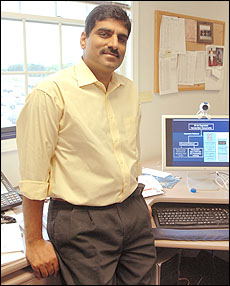Archives
Science fiction becoming science fact
Venu Govindaraju spearheads cutting-edge research at CUBS, CEDAR
By KEVIN FRYLING
Reporter Staff Writer
In the future, UB faculty member Venu Govindaraju says, cameras will recognize passengers' faces at the airport, while touchless sensors scan fingerprints or sniff out chemical and biological markers; smart cards will confirm shoppers' signatures on the spot to prevent credit fraud, and search engines will find foreign, handwritten and ancient texts as easily as they locate Web pages today.

Venu Govindaraju has been at the
forefront of biometrics’ transformation into a red-hot topic in the
field of computer science.
PHOTO: NANCY J. PARISI
These are but a few applications of the cutting-edge research that Govindaraju spearheads as founding director of UB's Center for Unified Biometrics and Sensors (CUBS) and associate director of the Center for Document Analysis and Recognition (CEDAR). He holds a faculty appointment as a professor in the Department of Computer Science and Engineering, School of Engineering and Applied Sciences.
"A lot of it feels like it's out of science fiction," he says, "but 10 years ago, didn't you think it would be science fiction if you could watch a TV show on a cell phone? Today, you can just do it."
In the 15 years since he earned master's and doctoral degrees in computer science from UB, Govindaraju has been principal or co-principal investigator on about $50 million in research projects from such sources as the Army Research Labs, Office of the Director of Central Intelligence, National Security Agency, National Science Foundation (NFS), the John R. Oishei Foundation and Google.
"The center [CUBS] has brought in about $5 million of funding in various biometrics-related projects," he says. "We're just going into our fifth year, and for a young center I think we're doing quite well. I myself am surprised that we've been so successful. It must be the right place and the right time."
About half of Govindaraju's research relates to the field of biometrics, which he describes as "the science of identifying people." His introduction to the subject, he notes, came from his thesis work on facial recognition—a subject once considered more relevant to artificial intelligence than biometrics—and since then he has been at the forefront of biometrics' transformation into a red-hot field in computer science due to rising interest in both personal and national security.
"I worked on a project on character recognition as a final bachelor's thesis at IIT (Indian Institute of Technology)," Govindaraju recalls. "I think from then on this topic was of interest to me. It's quite mathematically intense; maybe that was the reason I picked it up."
Nowadays, Govindaraju says, CUBS looks at different aspects of biometrics. "We look at facial recognition, voice recognition, fingerprint recognition"—as well as iris recognition, gait recognition, odor detection and hand geometry—"and how to combine these different methods."
He explains that conventional identification methods require "tokens," such as badges, cards or keys—even passwords and PINs. "Someone else could take your keys and have the same access," he notes. "Or I could take your [credit] card, swipe it and write a nursery rhyme for your signature." Biometrics renders these tricks useless because high-tech cameras, scanners or smart cards ensure authentication based on person-specific characteristics—physical or behavioral.
"You can lose your keys or forget your PINs," Govindaraju says, "but you can't forget yourself."
One of the areas in which Govindaraju is a principal researcher involves a collaborative project with UB experts in such areas as electrical engineering and communication to train computers to detect deceit based on "micro-expressions of the face." The project, he says, seeks to eliminate such problems as bias, fatigue and other human errors from this emerging deceit hot-spot detection method. "Can you imagine someone sitting at the airport security counter asking everyone who comes in a question and then trying to study the expression on their faces to decide what's going on?" he asks. "We're putting together computer algorithms so that this same thing can be done by a program." The project's support includes $2.3 million from the Department of Defense and NSF.
Govindaraju also points to his efforts to create algorithms that comprehend handwritten text in Arabic, English, Hindi and Sanskrit-he is fluent in the latter three languages—as a further source of collaboration with UB colleagues. Support for this project, on which he has worked with Maureen Jameson, associate professor and chair of the UB Department of Romance Languages and Literatures, and other research related to digital libraries comes from both local business and federal government sources, including more than $1 million from the NSF since 2002.
Between his research in biometrics and other topics related to pattern recognition, Govindaraju estimates that he has been an integral part of more than 25 research projects and collaborations in the past four years alone.
"Essentially," he says, "CUBS is a place for us all to group together and discuss our projects. It's sort of a virtual center. Participating faculty come from all over campus."
He notes that the graduate students, postdoctoral scientists and visiting research scholars who assist in projects are crucial to the center's research, adding that many of the students who work in his lab are in the top of their classes. "I look for the best students and get them financial aid to continue their Ph.D. and work with them," he says. "It's a mutual interest to find the best students and get them involved in our projects." UB alumni who've contributed to CUBS projects have gone on to careers at such companies as IBM, Amazon, Motorola and Qualcomm, he says.
Govindaraju resides in Amherst with his wife, Padma, an embryologist with Medical Associates of Western New York, and daughters, Swati, 14, and Krishna, 11. The former college tennis player says he has become a familiar sight in his neighborhood over the years due to his near-religious habit of tracing a five-mile jogging route through the community.
